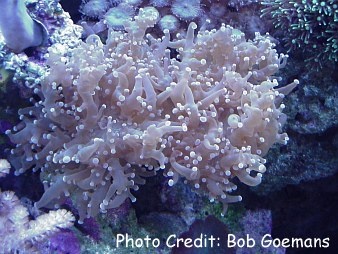
By Bob Goemans

Likely Reef Tank Suitable
Likely Fish-Only Tank Suitable
Range: Indo-West Pacific Ocean: Widespread.
Natural Environment: Inhabits protected, somewhat turbid mid-level slopes and usually seen at depths between 15 to 65 feet (5 - 20 m).
General Husbandry: Common in the trade and usually pale brown or green with the tips of the polyps an intense green or light brown color.
Do not place in areas receiving strong direct light or forceful water flow, as this may damage its polyps and possibly lead to rapid tissue necrosis (RTN) and its demise.
Its long fleshy polyps are fully extended during daytime and partially retracted during nighttime, at which time long sweeper tentacles are displayed in an effort to clear a path for expansion of the colony. These tentacles 'will' kill or greatly injure most other corals that it touches, therefore, leave sufficient space downstream from it. However, it can co-mingle without any tissue damage with E. ancora.
Even though photosynthetic, it can benefit from occasional hand feedings of meaty foodstuffs such as fortified brine shrimp, mysis, rotifers, and/or products containing Cyclop-eeze or similar foodstuffs and will take available plankton foodstuffs day or night.
Taxonomy:
Kingdom: Animalia
Phylum: Cnidaria
Class: Anthozoa
Subclass: Hexacorallia
Order: Scleractinia
Family: Euphyllidae
Genus: Euphyllia
FYI: Colonies may form large growths over 3 feet (1 m) in width and have somewhat translucent cream or green tentacles with pale tips. Photo of species in the wild courtesy of Wikimedia.
It has been reported that in aquariums containing leather corals, i.e., Sinularia species, Euphyllia spp. do not always fair well, possibly because of the chemicals released by Sinularia species. Personally, those in my past aquariums along various Sinularia species have not experienced a similar fate. But it's worth mentioning nevertheless.
Keep in mind most specimens found in stores are pieces broken off the original colony, which often tears its flesh, thereby opening the new specimen to infection. Add to that shipping stress and it often becomes difficult to find healthy specimens. Should RTN develop, treat with a diluted solution of Lugols iodine. I begin by first preparing a 'liter' of aquarium water containing 8 drops of Lugols iodine and mixing well. If feasible, I also prepare a small holding container (hospital tank), such as a glass fish bowl or small aquarium, just large enough to house the cleaned specimen. It is filled with aquarium water that has 4 drops of Lugols iodine added to it per 'gallon.' It has no substrate, but does contain a small powerhead for circulation and is moderately lit. When fully prepared, I remove the infected specimen and over an empty pail, used a soft brush and the prepared liter solution to remove as much brown jelly as possible. Then use a turkey baster filled with the remaining 8-drop solution and squirt only those brushed areas while continuing to hold the specimen over the empty pail. The specimen is then placed in the hospital tank, which should have the same pH, specific gravity, and temperature of the aquarium. It remains there, with 10% water changes (using water from the show aquarium with no additional Lugols) every other day until I'm sure the brown jelly infestation has ceased. If necessary, I'll repeat the cleaning process. I've found the sanitizing effect of the Lugols to often quickly end the invasion of brown jelly.
Always select a specimen that does not have any kind of alga growth on any of its exposed skeleton surface, as it will cause the tissue to recede, usually leading to the animals demise sooner or later.
Do not remove a specimen with highly inflated tissue areas from the water as the weight of the water in the polyps may damage or tear its flesh lose from its skeleton material. Gently shake the specimen and allow the flesh to retract somewhat before removing.
Photo of this species in the wild is provided free via the courtesy of Wikimedia.
Experience Level: Intermediate
Diet: Photosynthetic/Plankton feeder
Temperament: Aggressive
Aquarium Environment: Reef or fish-only aquarium
Coral Safe: With caution
Fish Safe: Yes
Invertebrate Safe: Yes
Acclimation Time: 30 minutes+
Aquarium Hardiness: Moderate
Calcium (Ca): 380 - 430 mg/l
Alkalinity: 2.5 - 3.0 meq/l
Phosphate (PO4): <0.05 mg/l
Magnesium (Mg): approx. 1350 mg/l (relate to specific gravity)
Strontium (Sr) 8 - 10 mg/l
Temperature Range: 72 - 82°F (22 - 27°C)
Minimum Tank Size: 30 gallons
Lighting: PAR 250 - 300
Water Movement: WM 1
Specific Gravity: 1.023 - 1.025
pH: 8.0 - 8.4
Iodine/Trace Elements Monitor/as necessary to maintain quality seawater.

.jpg)